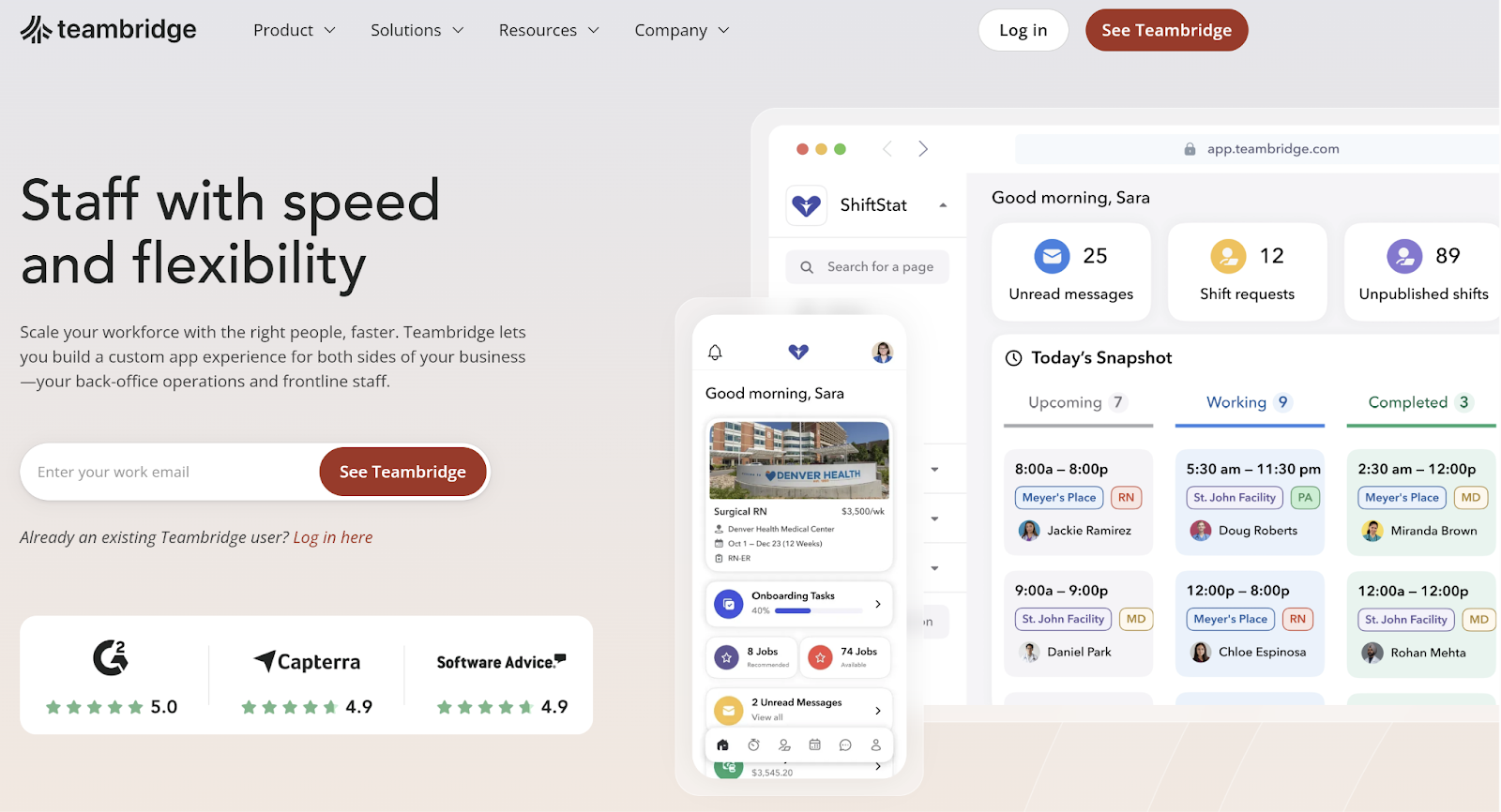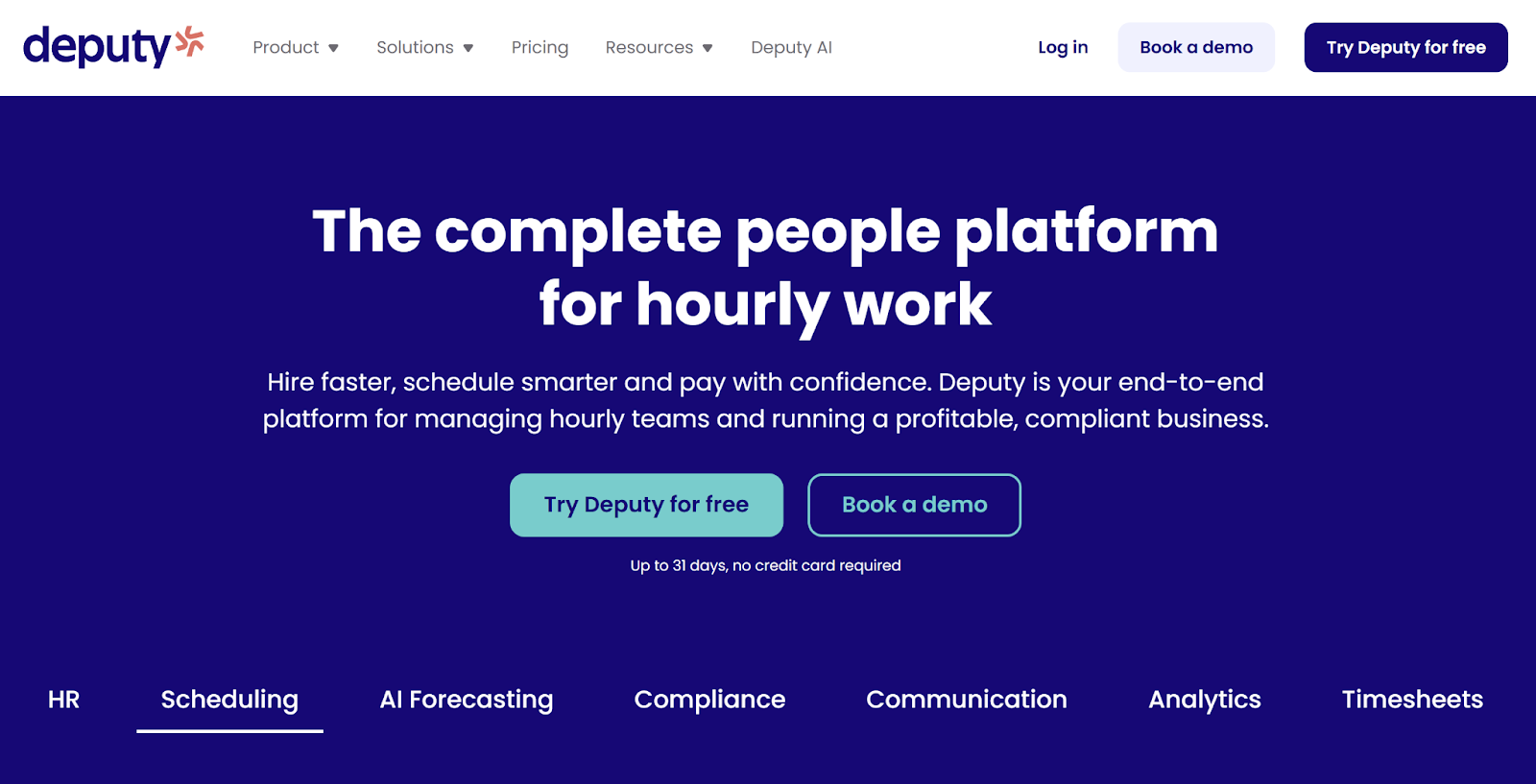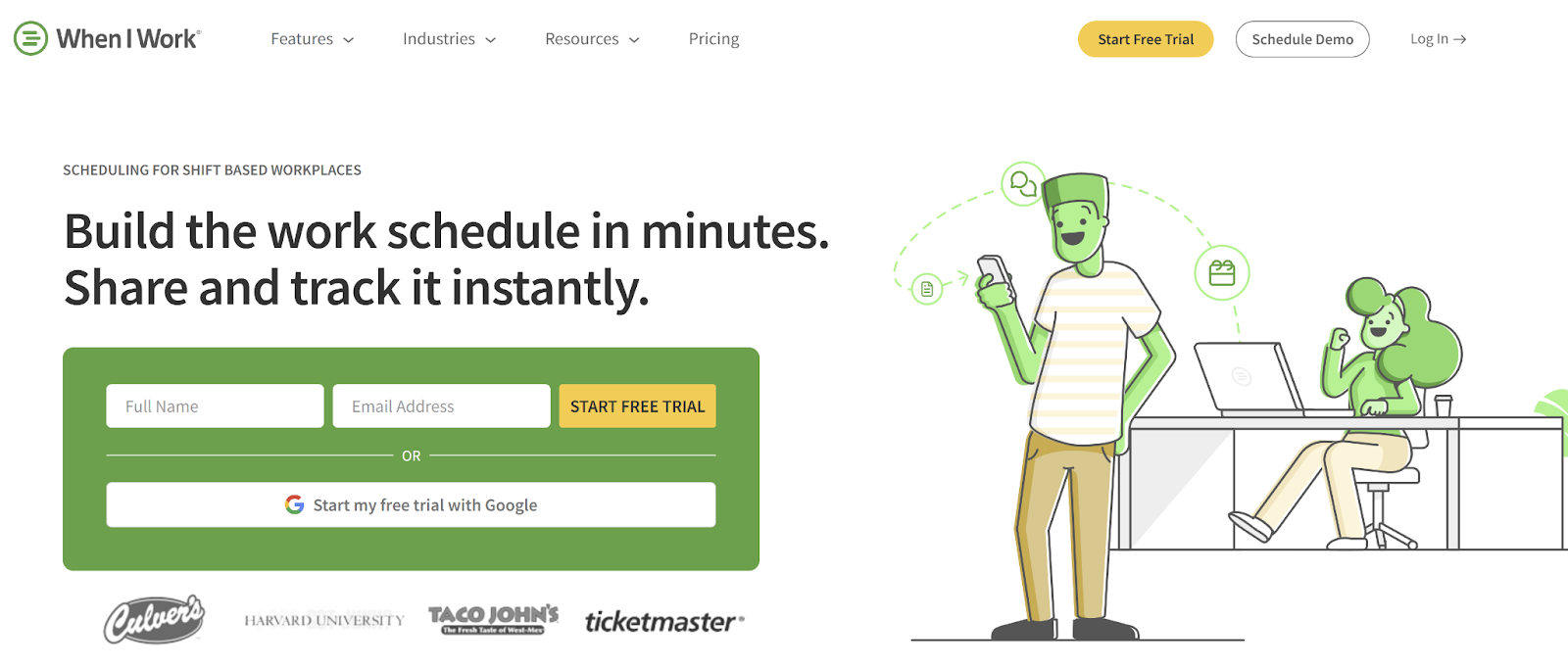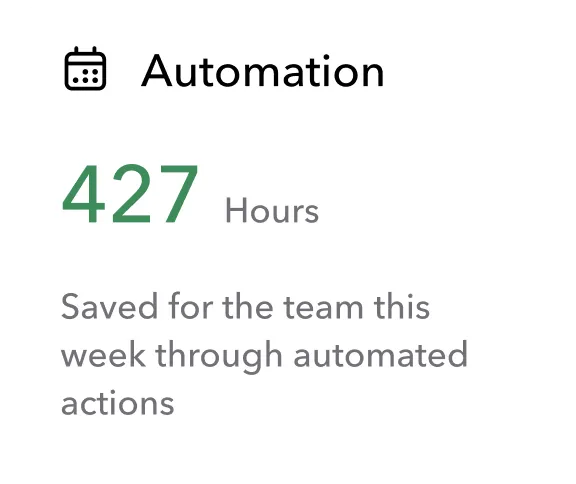Homebase has long been a go-to tool for small businesses managing hourly workers. Its simplicity and affordable pricing make it attractive for teams just starting to formalize their scheduling and time-tracking needs.
But as teams grow in size and complexity, the all-in-one solution’s cracks start to show. Operations managers who oversee multiple locations, compliance-heavy roles, or dynamic shift needs may find Homebase isn’t built to help them scale. This conclusion comes from gaps in intelligent staff scheduling tools, limited compliance oversight, and minimal customization options.
If you’ve hit the ceiling with Homebase, you’re not alone. Finding the best Homebase alternatives requires exploring more robust systems that are designed to match the complex operations facing shift-based firms today.
5 best Homebase alternatives for 2025 and beyond
The hardest part of searching for new software can be getting started. Here are five employee management platforms that offer deeper functionality, greater customization, and better support for medium-to-large enterprises that need more granular control over staffing workflows.
- Teambridge
- Deputy
- When I Work
- Humanity
- Sling
1. Teambridge
Teambridge is a contingent workforce management solution that uses custom rules to address complex operational needs. While its shared core capabilities for employee scheduling and time tracking are often cited alongside Homebase, Teambridge distinguishes itself through a high degree of workflow customization and built-in automation that match the needs of modern staffing agencies.

Key features:
- AI-powered credentialing: Ensure every new hire is compliant and ready to work on day one with automated document verification.
- Automated shift scheduling: Optimize labor based on business needs, availability, and compliance requirements.
- Self-service mobile app: Make it easy for staff to apply for jobs, onboard, clock in, request time off, and communicate, all in one place.
- No-code automation builder: Automate everything from routine tasks to multi-step processes using either pre-built or custom templates—no coding knowledge or IT help required.
Limitations:
- Due to the level of customization available, users typically benefit from onboarding to get their system running the way they want.
- Teambridge doesn’t yet have a built-in payroll system, but it integrates with popular third-party payroll apps like ADP and Paychex.
2. Deputy
Deputy is a cloud-based workforce management tool designed for shift-based businesses with physical locations, such as those in retail and hospitality. Similar to Homebase, the platform has a user-friendly interface, but does offer some more advanced features for employee scheduling and time tracking.

Key features:
- Fair workweek tools: Stay compliant with fair workweek laws by using forecasting to create advance-notice schedules.
- AI labor forecasting: Use AI tools to predict demand and optimize labor coverage.
- Scalable labor law compliance: Automate compliance with key wage and hour laws, including meal and rest breaks and overtime pay.
Limitations:
- Deputy offers limited custom workflows, which makes it less flexible for enterprise-level needs.
- Its reporting depth can fall short for more advanced operations compared to other solutions on this list.
3. When I Work
When I Work is a time and attendance tracking system that emphasizes simplicity. Like Homebase, it focuses heavily on time clock and scheduling features, but it’s more comprehensive. It also has a mobile app, so it can support businesses that need on-the-go management.

Key features:
- Two-way scheduling: Enable staff to schedule their own shifts with an employee mobile app.
- Built-in team messaging: Send individual and group messages without having to give away personal phone numbers.
- Geofencing and photo clock-in: Require users to take a photo when clocking in and out to help prevent time theft.
Limitations:
- The platform doesn’t offer major compliance tools like credential tracking or built-in labor law safeguards.
- It can be limited in its scalability for multi-location or enterprise use cases.
4. Humanity
Humanity by TCP Software is employee scheduling and workforce planning software designed for industries with stringent scheduling needs, like healthcare and public safety. It offers forecasting, shift bidding, and rule-based scheduling to bolster team management at large enterprises.

Key features:
- Task management system: Add tasks and instructions to any shift and monitor the time spent on each task.
- Built-in labor cost analysis: Monitor labor expenses for each schedule and adjust as needed.
- Automated demand scheduler: Create schedules based on historical demand data and your staffing rules.
Limitations:
- The platform has some kinks with its scheduling and messaging features that may require manual workarounds, according to user reviews on Capterra.
- Humanity can have a steeper learning curve for team members used to simpler tools.
5. Sling
Sling is a scheduling-first solution used by restaurants and retail stores. While Homebase aims to provide an all-in-one platform, Sling focuses on scheduling, task management, and team communication. Its various pricing models can suit multi-location businesses and budget-conscious teams that need better scheduling functionality.

Key features:
- Advanced scheduling tools: Manage shift swaps, detect conflicts, and maintain budgets.
- Seamless payroll: Track time worked and export timesheets for easier payroll processing.
- PTO management: Cap paid time off by leave types and approve requests based on remaining balances.
Limitations:
- Sling offers limited automation and AI features, which means you’ll still need some manual processes.
- Reviews indicate the interface isn’t as intuitive as teams would like, according to G2.
Key criteria to help evaluate Homebase alternatives
Choosing the right platform isn’t just about replacing what Homebase does. It’s about upgrading to a tool that supports where you’re going. While every company has different needs as it scales, here are four critical areas to consider when assessing your options.
Operational complexity
If you’re managing dispersed teams, multiple worksites, or roles with varying requirements, you need a platform that can handle operational complexity. Look for a tool that can support:
- Role-based access controls to maintain security and clarity
- The ability to assign different rules, permissions, and workflows across regions or units
- Management of multiple locations, job roles, and departments
For example, if you operate a healthcare organization with five facilities, you may need to set unique rules and credentialing requirements for each location. Having a solution that supports this helps ensure compliance and proper staffing without manual oversight.
AI and automations
Manual scheduling, availability tracking, and time-off approvals create bottlenecks, especially as you scale. Intelligent platforms that use AI and automation save time and help reduce costly mistakes.
Search for AI-enabled features like:
- AI-assisted scheduling based on labor demand, availability, and compliance
- Smart alerts for overlapping shifts, overtime risks, or missing credentials
- Automated shift swaps and approvals to streamline manager workloads
Some solutions also use AI to enable customization without in-depth technical knowledge. Teambridge, for instance, allows you to simply describe the policies you want to enforce for time tracking and scheduling, then generates code automatically. This lets you create any policy you need.
Compliance and credentials

Compliance and credentialing are where many platforms, including Homebase, fall short. As operations grow, the risk of noncompliance with labor laws, union rules, and industry-specific regulations grows too. The right solution helps you stay compliant with features like:
- Credential tracking tied to staff profiles to ensure certifications and licenses stay up to date
- Automated alerts for expired or missing documentation
- Built-in rules for overtime, break laws, and local labor compliance
Customization and integrations
Every business runs differently, and your software should reflect that. A strong Homebase alternative will adapt to your workflows instead of forcing you to fit its mold. Some features to watch for include:
- Integration capabilities with payroll, POS, human resource information systems (HRIS), and communication tools
- Tailored workflows for shift approvals, time-off policies, or compliance exceptions
- Custom dashboards with drag-and-drop components for easy adjustments
For example, with solutions like Teambridge, you can build schedule views that make it easy to spot coverage gaps visually. This can be especially helpful for organizations like staffing agencies that frequently deal with last-minute schedule changes.
Choosing an ideal Homebase alternative for your team
Needing a Homebase alternative is a sign of growth, not failure. It means your team needs more control, flexibility, and intelligence to manage the challenges of scaling your business.
Modern operations demand modern solutions. If you’re duplicating work across systems or spending too much time chasing compliance, it’s time to move beyond basic tools. Whether you're expanding locations, managing compliance-heavy roles, or looking for real-time visibility, a contingent solution like Teambridge can support your next phase of growth—and beyond.
Schedule a free demo of Teambridge to start evaluating your options and see why shift-based teams are moving away from Homebase.
Frequently asked questions about Homebase alternatives
Why consider a Homebase alternative?
As teams grow in size, complexity, or regulatory responsibility, they can find Homebase too limited for their evolving needs. Features like intelligent scheduling, compliance tracking, and multi-location visibility are either basic or missing altogether. A more advanced program can save time, reduce risk, and provide the flexibility needed to manage a modern workforce.
What’s the best Homebase alternative?
The best Homebase alternative depends on your team’s size, industry, and business needs. If you’re overseeing multiple locations, navigating strict compliance requirements, or hoping to automate manual scheduling tasks, you’ll likely want a platform that offers robust features like AI-assisted scheduling, credential tracking, and strong integration capabilities. Consider prioritizing tools that can scale with your business and adapt to your unique workflows.




.png)




.png)
.png)